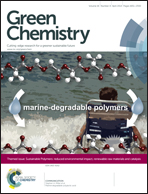Water-soluble hemicelluloses for high humidity applications – enzymatic modification of xyloglucan for mechanical and oxygen barrier properties†
Abstract
Bio-based polymers are of increasing interest in packaging applications as alternatives to petroleum-based polymers. Xyloglucan (XG) derived from tamarind seed waste was recently explored as a high performance biopolymer for packaging applications. Xyloglucan films have high strength, stiffness and oxygen barrier performance, but suffer from limitations in properties under high humidity conditions. This aspect is addressed in the present work using XG modification by enzymatic removal of side chain galactose residues. The modified XG was characterized using carbohydrate analysis and MALDI-TOF MS analysis for sugar and oligosaccharide compositions respectively. The consequence of galactose removal for XG chain packing was theoretically predicted using a group contribution method and the estimation of Hansen's solubility parameters. The properties of films made from modified XG in terms of tensile, oxygen transmission rate, and thermo-mechanical behaviour were measured and related to the structure of modified XGs. Modified XG films preserved the Young's modulus at high humidity at a level of 4.3 GPa at 92% relative humidity. Moreover, the oxygen permeability of modified XG samples was very low and was about 1.5 cc μm [m2 day]−1 kPa−1 at 80% relative humidity, more than 80% lower than that for native XG. The main reason is that modified XG absorbs less moisture, due to a decreased solubility. Decreased free volume may also contribute, as galactose residues are removed and XG branches become shorter.


 Please wait while we load your content...
Please wait while we load your content...